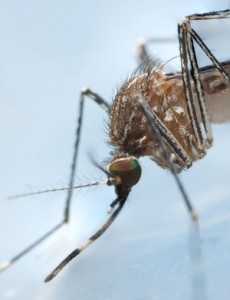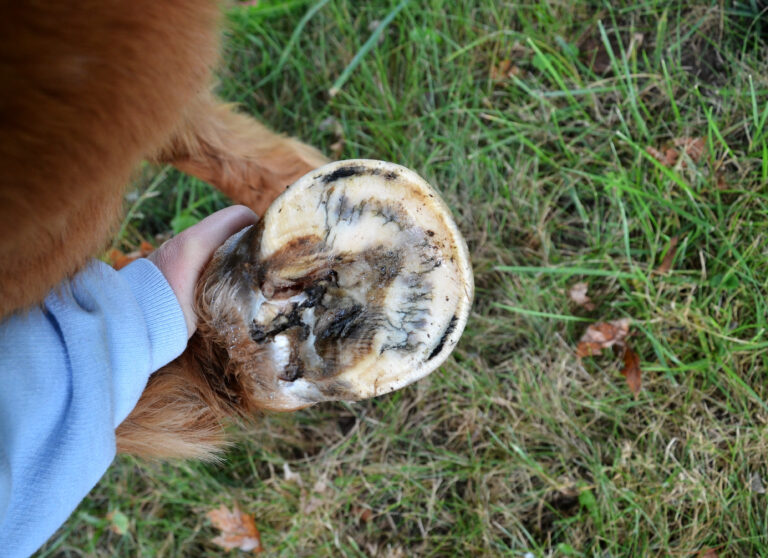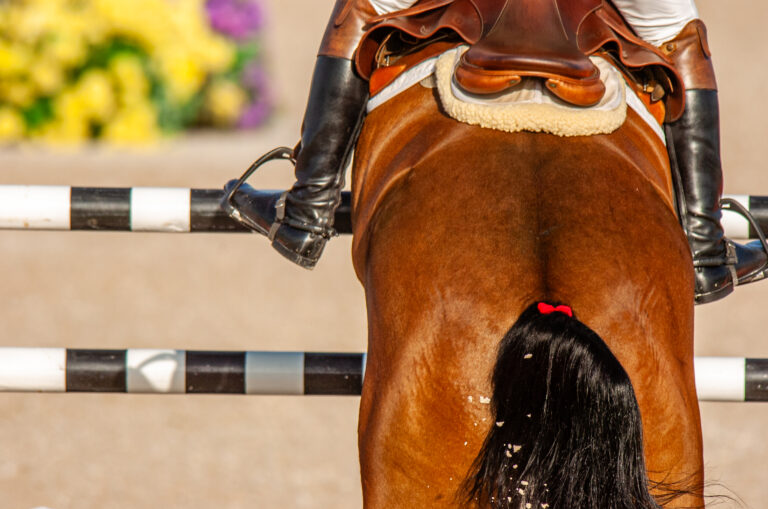Your horse hesitates and steps awkwardly when he walks downhill. He’s dragging his toes, too, and a few times he has even stumbled while trotting in the ring. He doesn’t seem sore, and your trainer and farrier don’t see anything wrong with his feet but you know he’s not right. Could he have one of several equine neurological disorders, like equine herpesvirus type 1 (EHV-1) equine protozoal myeloencephalitis (EPM) or West Nile virus?

Owners dread equine neurological disorders, such as equine herpesvirus type 1, equine protozoal myeloencephalitis or West Nile virus, and no wonder. Many of these problems are hard to diagnose and hard to treat, and they can damage a horse’s nervous system in ways that leave him unsafe to ride. But every neurologic case doesn’t end badly, and quick action—recognizing signs, getting a diagnosis and starting appropriate treatment—can give your horse the best chance.
If you think your horse might have a neurologic problem, it’s time to call your veterinarian. What exactly will your vet do, and what disorders might she find? In this article, we’ll walk you through a standard neurologic exam, tell you what else may be needed to make a definitive diagnosis and give you an overview of the most common problems.
Sorting Out the Signs
Signs of neurologic problems in horses run the gamut—seizures, abnormal behavior, abnormal gait, facial paralysis and more, says Debra Sellon, DVM, professor of equine medicine at the Washington State University College of Veterinary Medicine. “The most common neurologic problem equine veterinarians see in the United States is an abnormal gait,” Dr. Sellon says. “Affected horses are usually ataxic and weak, meaning that they walk with a staggering or drunken type of gait. They may drag their toes, stumble frequently or sway back and forth when they walk.”
Disruptions in a horse’s command and control system create these problems. For normal movement, nerve signals must flow from his brain along his spinal cord to the nerves that govern his muscles and nerves must signal back to his brain, reporting where his limbs are. If the signals don’t get through, your horse may become uncoordinated or develop abnormal gaits.
Many neurologic disorders can disrupt the signals. In most parts of North America, Dr. Sellon says, the most common are equine protozoal myeloencephalitis and cervical vertebral malformation (“wobbler syndrome”). But there are plenty of others, including injuries, several viral diseases and degenerative conditions, such as equine degenerative myeloencephalopathy, which has been linked to vitamin E deficiencies in young horses.
“Veterinarians use a fairly standard approach to determine a diagnosis for horses with neurologic disease,” Dr. Sellon says. The process begins with gathering information on your horse’s history. When did he begin to stumble or show other signs? Has he fallen? Information on your horse’s age, breed and use is important because some neurologic problems are more common in certain groups of horses.
Step two is a thorough physical examination. This exam may reveal soreness or other non-neurologic causes for your horse’s signs, or it may turn up signs of an injury or a disease that produces neurologic problems. As she examines your horse, your vet compares the right and left sides of your horse’s body, looking for asymmetry and loss of muscle mass (atrophy) that may develop when muscles go unused, as happens in some neurologic conditions. She may check the range of motion in his neck by encouraging him to bend to each side, using a carrot or another treat as a lure. Limited range of motion may mean an injury or even fractured vertebrae in his neck (the cervical spine).
Neurologic Exam
The third step is a detailed neurologic examination. “The goal is to determine, to the best extent possible, the site in the nervous system that is affected,” says Dr. Sellon. By finding out which functions are impaired, your veterinarian can figure out which nerves are involved. The process, called lesion localization, typically includes these steps:
General assessment: Your veterinarian observes your horse’s mental status and behavior. Is he alert or lethargic? Standing or down? Wandering aimlessly, circling or showing other odd behaviors or postures?
Basic reflexes: This part of the exam starts at the head with tests of the cranial nerves, which are involved in functions like hearing, vision, swallowing and facial sensation and muscle control. To test vision, for example, the vet quickly moves a hand toward your horse’s eye to trigger the menace reflex; your horse should blink and perhaps jerk away.
Along your horse’s neck and back on each side of his spine, your vet uses a ballpoint pen or similar object to touch your horse’s skin. A light but firm touch should trigger the panniculus reflex, the skin twitch you see when your horse is pestered by a fly. Lack of a reaction in any area suggests a problem with the nerves that supply that region. At the hind end, the vet checks muscle tone by lifting the tail; a limp tail may be a sign of a spinal cord problem. When his anus is gently stimulated, it should pucker and your horse should clamp his tail.
Maneuvers in hand: These tests show if your horse has control of his limbs and knows where his feet are. The vet watches as your horse is backed and turned in very tight circles in both directions to see how he places his feet. A normal horse keeps his rhythm and steps under his body, while a horse with a neurologic problem may interfere, take confused steps, swing a hind leg wide or pivot on one leg.
On a slope: Your vet may ask to see your horse led up and down a slope, to see if he stumbles, drags his toes or shows other gait abnormalities. Repeating this test with your horse’s head raised sometimes makes the signs more obvious.
Tail pull: This helps your vet assess your horse’s balance, strength and reaction time. As a handler leads your horse forward, your vet grasps his tail and pulls it firmly to the side. A normal horse will resist the pull; a horse with a neurologic problem may be tipped off balance. The test is repeated on the other side.
Foot placement: These tests help determine your horse’s awareness of his limb position. Your vet takes each foot in turn and places it over its opposite number—left front over right front, right front over left front, and the same behind. A normal horse will immediately put each foot back where it belongs; a horse with a neurologic problem may leave one or more feet out of place for a time.
By the end of the exam your veterinarian should know whether your horse’s problem is neurologic and, if so, what areas of his nervous system are involved. She may not have enough information for a clear diagnosis yet because many neurologic disorders have variable signs. “Horses with EPM can show a wide variety of signs, ranging from ataxia and weakness, to individual nerve paralysis, to seizures, to problems with urination or defecation,” Dr. Sellon says. “The vast majority of wobblers present for examination with ataxia and weakness of all four limbs. That means a horse with EPM often looks different from a wobbler but sometimes looks just the same.”
Still, your veterinarian will have enough information to make a list of the diseases or disorders that are most likely the cause and then choose the most appropriate diagnostic tests to confirm or rule out the items on that list. Here’s what you can expect for three common conditions.
EPM
This disease is common in most parts of the United States, Dr. Sellon says, but diagnosing it can be problematic.
Cause: Microscopic protozoan parasites (Sarcocystis neurona) invade the horse’s central nervous system, damaging the spinal cord and/or brain. S. neurona is mainly carried by opossums, which shed sporocysts (dormant protozoa) in their feces. The horse ingests the sporocysts in contaminated feed or water. (Another protozoan, Neospora hughesi, has been reported in a small number of cases.)
Signs: Depending on the area of the central nervous system that’s affected, signs may include loss of coordination, loss of muscle mass, difficulty swallowing, abnormal gait or lameness, seizures or paralysis. Signs are often more pronounced on one side of the body, Dr. Sellon says.
Diagnosis: Blood and spinal fluid can be tested for antibodies against the EPM parasite, and a negative result rules out the disease. But a positive test doesn’t necessarily mean that your horse has EPM just that he was exposed to the parasite at some time and mounted an immune response to fight it off. In some regions, 30 to 60 percent of horses have antibodies, but only a small fraction ever show signs of disease. Some new tests have been reported to give a clearer picture of antibody levels. But, Dr. Sellon says, a panel of experts has agreed that test results alone are not enough?it’s important to rule out other possible diseases as well.
Treatment: Drugs used to fight EPM include pyramethamine/sulfadiazine (or sulfamethoxazole) combination (paste, from compounding pharmacies) and ponazuril paste (Marquis, from Bayer). There’s also a pelleted medication, diclazuril (Protazil, from Intervet International), which can be top-dressed on feed if you’re sure your horse will consume the full dose. All the drugs are expensive, and treatment lasts weeks or months.
Be guided by your veterinarian in choosing what’s right for your horse, Dr. Sellon says. “The advertisements for some new diagnostic and treatment procedures may sound very exciting, but they may not have solid science backing them up.”
Outlook: Without treatment your horse will get worse. Medication can halt the progression of the disease, but his recovery depends on how badly nerve tissues have been damaged. If your horse is diagnosed and treated promptly, he may recover fully; but a severe or longstanding case may cause lasting neurologic deficits.
Prevention: So far no vaccine has proved effective against EPM, although research continues. You can take other steps to reduce your horse’s risk:
- Minimize stress. Stress from showing, shipping, training and the like seems to increase the risk of developing this disease, perhaps by suppressing your horse’s immune response.
- Discourage opossums. They’re scavengers, so cover grain and garbage tightly. Clean up spilled grain and dispose of dead animals, including birds and rodents. Keep water troughs and buckets clean and filled with fresh water to prevent contamination.
Wobbler Syndrome
Wobbler syndrome usually appears in young, growing horses. It’s the most common noncontagious cause of neurologic problems.
Cause: The bones of the spine (vertebrae) have a central canal that lets the spinal cord pass through. A wobbler has a structural narrowing of the canal in vertebrae of the neck—a cervical vertebral malformation (CVM) that squeezes the spinal cord and damages nerve tissue. The pressure may be constant or occur only when the neck is flexed or extended. Rapid growth, a diet excessively high in nutrients and imbalances of various minerals have been blamed. The condition can affect any breed but is especially common in Thoroughbreds, and genetics may play a role. An injury to the spine may worsen the problem.
Signs: Your horse is incoordinated and weak behind and, often, in front as well. Usually both sides of your horse are affected equally. The signs may creep up gradually or appear suddenly, and the severity may vary from time to time.
Diagnosis: X-rays of the neck can help rule out a fracture, Dr. Sellon says, but confirming that your horse is a wobbler usually requires a myelogram. This is a set of specialized X-rays taken while your horse is anesthetized. A dye is injected into the space around his spinal cord, and the X-rays are taken with your horse’s neck in various positions to see if the bones impinge on the spinal cord.
Treatment: A wobbler may improve with rest, but the underlying condition doesn’t go away. In some cases a surgeon may be able to fuse the affected vertebrae to reduce pressure on the spinal cord.
Outlook: Most wobblers are not candidates for athletic careers. Successful surgery may improve the condition enough for your horse to be ridden, though.
Prevention: There’s no sure way to prevent CVM, but correct nutrition will help any young horse develop well.
Trauma
Injuries to the skull or spine can produce severe neurologic problems.
Cause: These injuries typically occur when a horse falls or collides with a solid object. For example, a horse who pulls back in cross-ties, panics and flips over backward may strike his poll, sometimes with enough force to fracture his skull or the first few vertebrae of his neck. An event horse who doesn’t clear an obstacle and flips or plows headfirst into the ground may fracture vertebrae farther along the spine.
Signs: Head trauma may knock your horse unconscious, make him temporarily blind or disoriented or kill him instantly. But signs don’t always show up immediately—pressure from internal bleeding in the skull can build slowly, so you won’t know initially how serious the injury is. Signs of spinal injury depend on the location. Your horse may have difficulty rising, lack coordination and show other abnormalities.
Diagnosis: Your horse’s history and signs generally point to injury. X-rays can identify fractures in the skull and spine, but some sites are difficult to image.
Treatment: If a fracture leaves your horse paralyzed or severely incoordinated, not much can be done. Treatment for milder injuries focuses on reducing the inflammation and swelling that put pressure on nerve tissue. Your vet may put your horse on anti-inflammatory medications, perhaps intravenous DMSO, a corticosteroid or a nonsteroidal anti-inflammatory such as phenylbutazone, depending on the case. Your horse will need a period of rest, followed by reevaluation.
Outlook: No two injuries are the same, so the outlook is different in each case. A horse with soft-tissue injuries obviously has a better outlook than a horse with a fractured spine.
Prevention: Accidents happen, but you can minimize your horse’s risks by being sure that he’s fit and ready for his sport and by avoiding situations in which he’ll fight head restraint. If you can’t tie him safely, don’t tie him.

Viral Threats
Several viral diseases can attack your horse’s central nervous system. Rabies, always fatal, may be the most devastating but, fortunately, it can be prevented with vaccination and is fairly rare. These are more common.
West Nile Virus. West Nile is one of several mosquito-borne viruses that cause neurologic disease in horses. In the United States, the others are Eastern and Western encephalomyelitis. Another, Venezuelan encephalomyelitis, hasn’t occurred north of the Mexican border since the 1970s. Here are the basics:
- Mosquitoes transmit the virus to horses when they bite. If the virus invades the central nervous system, it can cause encephalitis (swelling around the brain and spinal cord). The virus does not spread directly from horse to horse or from horses to people.
- Lack of coordination, weakness or paralysis of the hind limbs, muscle twitching, impaired vision, head pressing, aimless wandering, convulsions, circling and coma are some of the severe neurologic effects. Horses typically have non-neurologic signs, too, such loss of appetite and a depressed attitude. Some develop a fever. Lab tests can confirm the diagnosis.
- Your horse should have supportive care, including anti-inflammatory medication and IV fluids, if needed, but there’s no specific treatment.
- West Nile is fatal in 20 to 40 percent of cases. Horses who pull through may have lingering neurologic deficits, but that’s not always the case. Other forms of equine encephalitis have somewhat higher death rates and less chance of full recovery.
EHV-1. Equine herpesvirus type 1 usually causes a flu-like illness or, in pregnant mares, abortion. But in some cases, the virus damages blood vessels in the brain and spinal cord, producing a deadly neurologic disease (equine herpesvirus myeloencephalopathy).
- Neurologic signs may include lack of coordination, hind-end weakness, diminished tail tone or unwillingness to rise. Fever, nasal discharge and other respiratory signs may appear first. But, says Dr. Sellon, “Most of the EHV horses we see at WSU do not have nasal discharge or respiratory disease signs that have been recognized by owners or trainers,” Dr. Sellon says. “If you depend on those signs, I think you might miss a lot of horses with EHV infection.” Your veterinarian can send a nasal swab and blood sample to a lab to confirm the diagnosis.
- Supportive care can help your horse weather the infection. Antiviral medications may help if given before neurologic signs appear.
- The virus spreads easily from horse to horse; isolation, quarantine and other biosecurity measures will help keep the disease from spreading through the barn.
- Horses who remain able to stand usually recover. The outlook is not so good for those who go down and can’t rise.
All these viral diseases are widespread in the United States, so take steps to protect your horse:
Vaccinate:
- Vaccines against WNV, EEE and WEE are effective, and they’re considered “core” for practically all horses in the United States. Boosters are usually given annually in spring, giving your horse time to build immunity before mosquito populations peak in summer. Where mosquitoes are active year-round, horses may need more frequent boosters.
- No vaccine is labeled effective against the neurologic form of EHV-1, but vaccination can help protect your horse from other forms of the disease. There’s some evidence that a modified live virus vaccine (Rhinomune MLV, from Boehringer Ingelheim Vetmedica) offers better protection against the neurologic form, but more research is needed.
Reduce Risks:
- Limit your horse’s exposure to mosquitoes. Keep him in at dusk and dawn, when mosquitoes are most active, and use fly repellents labeled effective against these insects.
- Take precautions at shows and other places where many horses come together and contagious diseases like EHV-1 often spread. Don’t share water buckets or let your horse rub noses with strangers.
This article originally appeared in the November 2011 issue of Practical Horseman.











